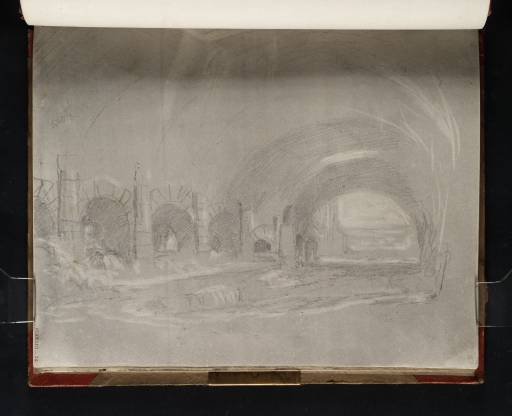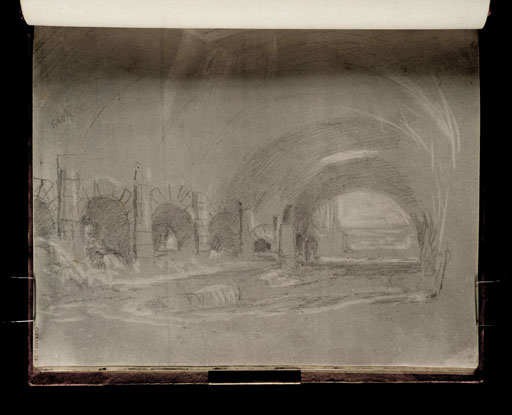Joseph Mallord William Turner The Via Tecta, beneath the Santuario di Ercole Vincitore, Tivoli 1819
Image 1 of 2
Joseph Mallord William Turner,
The Via Tecta, beneath the Santuario di Ercole Vincitore, Tivoli
1819
Joseph Mallord William Turner 1775–1851
Folio 20 Recto:
The Via Tecta, beneath the Santuario di Ercole Vincitore, Tivoli 1819
D15486
Turner BequestLXXXIII 20
Turner BequestLXXXIII 20
Pencil and grey watercolour wash on white wove paper, 200 x 253 mm
Inscribed by the artist in pencil ‘arch’ above line of arches, far left of sketch
Stamped in black ‘CLXXXIII 20’ bottom left, descending left-hand edge
Inscribed by the artist in pencil ‘arch’ above line of arches, far left of sketch
Stamped in black ‘CLXXXIII 20’ bottom left, descending left-hand edge
Accepted by the nation as part of the Turner Bequest 1856
References
1909
A.J. Finberg, A Complete Inventory of the Drawings of the Turner Bequest, London 1909, vol.I, p.540, as ‘Arches, Tivoli’.
1984
Cecilia Powell, ‘Turner on Classic Ground: His Visits to Central and Southern Italy and Related Paintings and Drawings’, unpublished Ph.D thesis, Courtauld Institute of Art, University of London 1984, p.174 note 19.
1987
Cecilia Powell, Turner in the South: Rome, Naples, Florence, New Haven and London 1987, p.[77] note 17.
The subject of this drawing is the Via Tecta, a gallery or tunnel built beneath the ruins of the Santuario di Ercole Vincitore (Sanctuary of Hercules Victor) in Tivoli. Formerly known as the Villa of Maecenas, the Santuario is in fact a large temple complex dating from the first century BC, dedicated to the cult of Hercules. The Via Tecta carried the ancient Roman road, the Via Tiburtina, beneath the substructures of the Santuario and was originally used for herding and selling livestock.1 Part of it is still extant, although the surviving remnants of the temple have been much altered by industrial use of the site between the seventeenth and twentieth centuries.2 Turner’s view looks along the passageway towards the daylight at the end. Visible within the vaults of the ceiling are two square-shaped openings, designed to let in light and air, whilst along the left-hand side of the wall are arched lateral spaces which were formerly shops flanking the road.3 Visual precedents for the subject include etchings by Giovanni Battista Piranesi (1720–1778) for the Veduta di Roma,4 and a watercolour by Louis Ducros (1748–1810), The Stables of the Villa of Maecenas at Tivoli (Stourhead, The Hoare Collection, The National Trust).5 Turner could have seen views by both artists in the collection of his early patron, Sir Richard Colt Hoare of Stourhead.
Like many drawings within this sketchbook, the composition has been executed over a washed grey background and Turner has effectively exploited the tonal properties of the paper to create an atmospheric study. He has created highlights by rubbing or lifting out the wash to reveal the white paper beneath, principally to depict the daylight at the end of the tunnel, and the square ceiling openings illuminating the interior. He has further enhanced the dramatic chiaroscuro by describing areas of deep shadow with vigorous hatching with soft, dark pencil. Related studies can be found on folios 9 and 10 (D15475 and D15476). Turner also made a large number of sketches of the exterior of the Santuario, see folio 5 (D15471).
See Barbro Santillo Frizell and Jonathan Westin, ‘Displaying Via Tecta: visualisation and communication’, in Hans Bjur and Barbro Santillo Frizell (eds.), Via Tiburtina: Space, Movement and Artefacts in the Urban Landscape, Stockholm 2009, pp.[219–21].
See Anna Maria Reggiani, Tivoli: Il Santuario di Ercole Vincitore, Milan 1998, figs.15 and 24, ‘Ingresso attuale della via tecta, frutto della risistemazione tardo-ottocentesca a cura della “Societa per le Forze Idrauliche e gli Usi Industriali e Agricoli’.
See Frizell and Westin 2009, p.[220] and compare a present-day photograph and reconstruction, figs.2 and 3.
Veduta interna della Villa di Mecenate and Altra veduta interna della Villa di Mecenate in Tivoli, see Luigi Ficacci, Piranesi: The Complete Etchings, Köln and London 2000, nos.944 and 955, reproduced pp.726 and 732.
Verso:
Blank, except for traces of grey watercolour wash
Inscribed by ?John Ruskin in red ink ‘350’ bottom left, and by unknown hand(s) in pencil ‘393’ bottom left, inverted, and ‘clxxxiii.20’ bottom left
Blank, except for traces of grey watercolour wash
Inscribed by ?John Ruskin in red ink ‘350’ bottom left, and by unknown hand(s) in pencil ‘393’ bottom left, inverted, and ‘clxxxiii.20’ bottom left
Nicola Moorby
February 2010
How to cite
Nicola Moorby, ‘The Via Tecta, beneath the Santuario di Ercole Vincitore, Tivoli 1819 by Joseph Mallord William Turner’, catalogue entry, February 2010, in David Blayney Brown (ed.), J.M.W. Turner: Sketchbooks, Drawings and Watercolours, Tate Research Publication, December 2012, https://www


